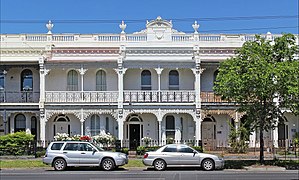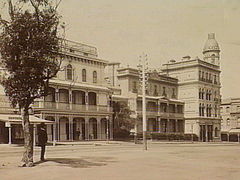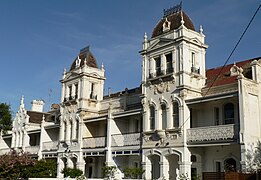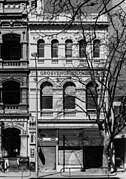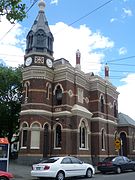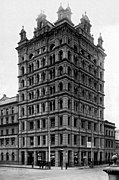Boom style architecture
"Boom style" is a term used to describe buildings from the Melbourne 1883-1889 Land Boom during which a massive property bubble created wildly speculative values for land and excessive borrowing. Boom style buildings were often rich in ornament and decoration. Initially borrowing was aided by generational wealth from the Victorian gold rush but fuelled by additional hype generated from the city's growing reputation as a boom town, including being labelled 'Marvellous Melbourne' by George Augustus Sala in 1885. Owners, confident that ever increasing prices would exceed their debts, would often engage architects to create exuberant designs in exotic styles that signified wealth something fashionable during the 1880s. However at the end of the boom in 1889 prices soared so high that properties pushed skyward to maximise the value of land which was itself excessively overvalued.[1] Borrowings far exceeded the value of the buildings and most of the Land Boomers ended in bankruptcy with most of the cost of construction never recovered, which had a ripple effect which by the early 1890s had crippled the Victorian economy. For a period of time the phrase was used derogatively during a period when the style was "on the nose" due to association with bad debts and corruption, as further justification for their demolition.[2][3]
Though the bubble existed elsewhere (Ballarat and Bendigo experienced relatively moderate speculation during the period) and ended with the Australian banking crisis of 1893, the term's use is rare elsewhere.[4][5] Sydney's construction from the period were more modest and contributed to its economy rebounding from the financial crisis whereas Melbourne's did not. The phrase is sometimes used, uncapitalised, to designate similar opulent architecture of overlapping periods across the late British Empire,[6] and to some extent in America.[7]
Background[edit]


In the 19th century, there was a significant increase in the construction of civic buildings in urban areas throughout the British Empire supported by the rise of the middle class and its leisure activities accommodated by theatres, shopping arcades, and coffee houses.[6] These buildings embraced the latest architectural trends incorporating both Gothic and classical elements in an unconventional manner to create visually stunning effects in a design approach, criticised in the Modernist period by such commentators as Freeland, as uneducated eclecticism or frivolousness.[8]
Australia[edit]
King and Willis[4] note that the term ‘Boom Style’ (as capitalised) has entered the lexicon of Australian architectural historians, its first usage being accepted as by Robyn Boyd in the 1952 edition of his Australia's Home.[9]
The Australian gold rushes led to a fivefold population increase within a mere thirty-year period attracting opportunists and adventurers from around the world and the resultant wealth funded the emergence, particularly in Melbourne, and to a lesser extent in Sydney and Brisbane,[10][11] of a lavish architectural style known since as the Boom style.[12] The period between the gold rushes and the major depression of the 1890s witnessed a significant surge in building activity, encompassing both residential and secular structures, as well as religious buildings.[5] Previously limited to three or four stories, commercial office buildings in the Boom Style reached 'skyscraper' heights.[4]
Melbourne[edit]

Melbourne in particular, as the capital of the colony in which most gold was discovered, experienced a rapid influx of money, which contributed to the city's growth. This period marked the prevalence of elaborately decorated Victorian architecture in the city recognised as ‘Marvellous Melbourne”[4][13] The centres of gold mining including Ballarat and Bendigo, and even the now smaller towns such as Clunes, Maryborough, Daylesford and Beechworth also feature such buildings.
Characteristics[edit]

In the late 1880s and early 1890s, the Boom Style gained prominence, featuring unrestrainedly ornate facades. Stucco parapets or balustrades concealed the roofs, colored-brick patterns were common, and cast-iron verandas and stained glass around the front doors were chararcteristc. Architectural historians categorise 'Boom style' into sub-styles such as Georgian Colonial, Gothic Revival, Renaissance Revival, and French Second Empire.
Architects rose to the challenge of providing wealthy clients' demands for ostentatious houses. Notable examples include "Benvenuta" in Carlton, designed by Walter Scott Law in 1892 for a small-arms manufacturer. Roman-inspired, and now known as Medley Hall, a residential college, is another example, featuring intricate garlands, encrustations of floral motifs, and statues on the parapet, all crafted by Italian artisans.[14]
Glass[edit]

During this era, coloured glass became a popular feature in private homes, adorning both modest terraces and grand mansions. The availability of relatively inexpensive glass due to the Industrial Revolution, its suitability as ballast on returning ships, and the public's inclination for ornamentation all contributed to its widespread usage. By the 1880s international exhibitions in Sydney (1879) and Melbourne (1880-81) had popularised sophisticated new products from manufacturing nations and the introduction of various types of specialty glass, adding a colourful element to the generally subdued tones of boom-style building materials. Painted and enameled decorative panels, etched ruby glass, and high-quality Victorian leadlights, featuring thick and deeply colored quarries and sparkling roundels, were incorporated into door settings, stairwells, and hallway windows. The role of the stained glass window is showcased in Labassa, an Italian-inspired villa in Caulfield North, constructed in 1890 for W. A. Robertson, a pastoralist and investor. Designed by J. A. B. Koch and again built by Italian craftsmen, the villa exhibited extensive sculptural ornamentation and extravagant use of stenciled decorations and stained glass.[15]
Architects[edit]
- George Henry Male Addison:[10] The Albert Street Uniting Church, Brisbane, (1889);[16] Cliveden Mansions, Spring Hill (1888);[17] The villa Kirkston, built in 1888–89 at Windsor[18] Extensive additions to Stanley Hall, Clayfield, (1889);[19]The Mansions, 40 George Street, Brisbane (1889); Fernbrook, his home in Indooroopilly (c. 1889, demolished in the 1920s);[11][20] Cumbooquepa, South Brisbane (1890) ;The Old Museum Building, Brisbane, (1891)
- James Birtwistle (1857-1939): Illawarra, Toorak (1889); Great Southern Hotel, Beaumaris (1889); Preston Town Hall (1895, uncompleted)
- Thomas James Crouch (1832 - 1889): Deloraine Terrace, Parkville, 1887; Melbourne General Post Office (design ultimately went to A. E. Johnson); Methodist Ladies College
- George De Lacy Evans: Marks’ Warehouses, 29 Niagara Lane, Melbourne (1887); Sum Kum Lee Building, Lt. Bourke St, (1888)
- Harry Browse Gibbs (1858–1918): George Hotel, Fitzroy Street, St Kilda (1886, corner section); Crossakiel, 26 Kooyongkoot Road., Hawthorn (1884-6)
- Norman Hitchcock (c.1837-1918): Holcombe Terrace, Carlton; 70 Albert Street, East Melbourne;[21] Victoria Buildings, 193-207 Smith Street, Fitzroy (1889); Melbournia Terrace, 1 - 13 Drummond Street,, Carlton
- Arthur Ebden Johnson: Melbourne General Post Office (additions 1887); Melbourne Athenaeum (1886); Eastern Hill Fire Station (1893)
- William Pitt: designs include: Premier Permanent Building Society 1882 (demolished); Melbourne Coffee Palace in 1882 (demolished in the 1960s); Princess Theatre; The Federal Coffee Palace (demolished in 1972); Olderfleet buildings; Old Safe Deposit Building; Old Rialto Building; Former Melbourne Stock Exchange; Grand Hotel, Yarra Glen
- Joseph Reed (c. 1823–1890): Royal Exhibition Building, 1880; Ormond College, Melbourne University (1881); Holy Trinity Church, East St Kilda (1882–1889); Old Pathology Building, Melbourne University (1885); Sacred Heart Church, St Kilda (1884); Lombard Building (15-17 Queen Street) (1887); Baldwin Spencer Building, Melbourne University (1887); Old Physics Conference Room and Gallery, Melbourne University (1888)
- Lloyd Tayler (1830-1900): Chevy Chase, 203 Were Street, Brighton (1881)
- Edward Twentyman (from 1882 – Twentyman and Askew) Cairns Memorial Church, East Melbourne (c1886), Colonial Sugar Refinery, Port Melbourne (c1886); Block Arcade, Collins Street (1890-93); Campi Buildings at 149-167 Queens Parade, Clifton Hill (1883)
- William Charles Vahland (1828–1915): Bendigo Town Hall (1885), Shamrock Hotel (1897)
- Charles Webb: Hotel Windsor,[22] Royal Arcade,[23] South Melbourne Town Hall,[24] Tasma Terrace,[25] and his own home at 6 Farleigh Grove are all listed on the Victorian Heritage Register.
- William Wolf: Lalor House, Richmond, 1888;[26] Nathan’s Terrace, Flemington, 1888; Canterbury Mansions, Canterbury, 1889
Demise[edit]
With a recession and the collapse of banks in 1893 and following that, the demise of numerous newly established companies, the building industry embraced a more modest style that reflected the prevailing sobriety.
The "Queen Anne" revival style emerged in deliberate contrast to the Boom Style, characterised by meticulously pointed red bricks and newly imported Marseilles-pattern roofing tiles made of terra-cotta, and abandoning the use of stucco. Grey slate was replaced with red tiles, while the folded M-shaped roof expanded to form a high, all-encompassing cap. Instead of formal symmetry, the plan and silhouette of buildings transformed into an assortment of irregular bays, dormers, porches, and spires, striving to achieve a "picturesque" appearance, and a more homely 'English' quality.[9]
- Further examples
-
Shubra Hall and the Main School Building and students of the Presbyterian Ladies' College, Sydney, 1892.
-
Studley Park, Camden circa 1900
-
Mudgee railway station, architect John Whitton
-
Lombard Building, Queen Street, Melbourne, 1890. Architects Balfour, Elliott & Co.
-
Heritage Hotel, Bulli, New South Wales, 1889. Kenwood and Kerle architects
-
Shamrock Hotel, Bendigo, 1897. Designed by Phillip Kennedy
-
Trinity Terrace, Royal Parade, Parkville, Melbourne
-
Bendigo Town Hall, architect William Vahland, 1885
-
Victorian terrace on canterbury road, Middle Park
-
Cintra House, Maitland, architect John Wiltshire Pender, 1889
-
Fitzroy Street, St Kilda in 1890
-
Marion Terrace, St Kilda
-
Grosvenor Chambers. Architects Oakden, Addison and Kemp, 1888
-
Flemington Post Office. Architect J. R. Brown, 1888
-
Equitable Building, Collins Street, architect Edward Raht, 1896
-
Federal Coffee Palace, Melbourne, designed by Ellerker & Kilburn and William Pitt, 1888
-
Fink's Building, Melbourne. Architects Twentyman & Askew, 1888
-
Parer's Crystal Cafe, Bourke Street, Melbourne 1886
References[edit]
- ^ Land Boom in 1880s Melbourne - Museum Victoria
- ^ Cannon, Michael (1995). The Land Boomers. Melbourne University Publish. ISBN 0-522-84663-7.
- ^ How cultural cringe spelled the end of Marvellous Melbourne buildings, and how locals eventually fought back by David Schout for CBD News. November 2022, Issue 92 17
- ^ a b c d King, Stuart; Willis, Julie (2022-07-05). "Mining Boom Styles". In Brennan, AnnMarie; Goad, Philip (eds.). Proceedings of the Society of Architectural Historians, Australia and New Zealand: 33, Gold. Proceedings of the Society of Architectural Historians, Australia and New Zealand. online: SAHANZ. pp. 334–345. ISBN 978-0-646-85443-4.
- ^ a b MacMahon, Bill; Sierins, Eric (2000). The architecture of East Australia : an architectural history in 432 individual presentations. Stuttgart: Edition Axel Menges. p. 10. ISBN 9783930698905. OCLC 636811671.
- ^ a b Bremmer, G. A., ed. (2016). Architecture and urbanism in the British Empire. Oxford history of the British Empire (1st ed.). Oxford: Oxford University Press. ISBN 9780198713326. OCLC 938360468.
- ^ Knapp, A. Bernard; Pigott, Vincent C; Herbert, Eugenia W. (1998). Knapp, A. Bernard; Pigott, Vincent C; Herbert, Eugenia W. (eds.). Social approaches to an industrial past : the archaeology and anthropology of mining (1st ed.). London: Rautledge. p. 31. ISBN 9780415181501. OCLC 848864777.
- ^ Freeland, J.M. (1972). Architecture in Australia : a history. Ringwood, Victoria, Australia, New York, N.Y., U.S.A: Penguin Books Australia. ISBN 9780140211528. OCLC 24010185.
- ^ a b Boyd, Robyn (1987). Australia's home : its origins, builders, and occupiers (New M.U.P. ed.). Carlton, Vic.: Melbourne University Press. pp. 25–44. ISBN 9780522843583. OCLC 18648524.
- ^ a b East, John W (2022-01-01), Subtropical Aestheticism: The Brisbane Architect, George Henry Male Addison (1857-1922), and his Work, John East, retrieved 11 July 2023
- ^ a b De Vries, Susanna and De Vries, Jake (2013). Historic Brisbane: Convict Settlement to River City. Pandanus Press. p. 74. ISBN 9781922109804.
{{cite book}}: CS1 maint: multiple names: authors list (link) - ^ Margalit, Harry (2019). Australia : modern architectures in history. Modern architectures in history (1st ed.). London: Reaktion Books. pp. n.p. ISBN 9781789141245. OCLC 1120198701.
- ^ Goad, Philip; Bingham-Hall, Patrick (1998). A guide to Melbourne architecture. Balmain, N.S.W.: Watermark Press. p. 1880. ISBN 9780949284365. OCLC 39443558.
- ^ Flower, Cedric; Smith, Robyn (1983). The Heritage of Australia (2nd ed.). Ringwood, Australia: Viking O'Neil. p. 86. ISBN 9780670900060. OCLC 680053649.
- ^ Zimmer, Jenny (1984). Stained glass in Australia (1st ed.). Melbourne: Oxford University Press. p. 49. ISBN 9780195543698. OCLC 12031913.
- ^ "Albert Street Uniting Church (entry 600066)". Queensland Heritage Register. Queensland Heritage Council. Retrieved 10 March 2014.
- ^ "Cliveden Mansions (entry 602186)". Queensland Heritage Register. Queensland Heritage Council. Retrieved 10 March 2014.
- ^ "Kirkston (entry 600351)". Queensland Heritage Register. Queensland Heritage Council. Retrieved 10 March 2014.
- ^ "Stanley Hall (entry 600183)". Queensland Heritage Register. Queensland Heritage Council. Retrieved 10 March 2014.
- ^ Grubb, Ken (2013). Silver Hill: The University of Queensland Silver Mine Precinct. p. 32.
- ^ "East Melbourne, Albert Street 070 - Burchett | East Melbourne Historical Society". emhs.org.au. Retrieved 2023-07-11.
- ^ "Hotel Windsor: There's life in the old girl yet". Sydney Morning Herald. 22 September 2009. Retrieved 15 April 2010.
- ^ "Trust will fight 3 wreckings The National Trust has again". The Age. 27 February 1978. Retrieved 15 April 2010.
- ^ "South Melbourne Town Hall Community Hub Opens". Archived from the original on 20 June 2009. Retrieved 15 April 2010.
- ^ "A register of treasures". The Age. 13 March 1979. Retrieved 15 April 2010. [dead link]
- ^ "Lalor House". Heritage Victoria. 18 July 2006. Retrieved 11 July 2023.









